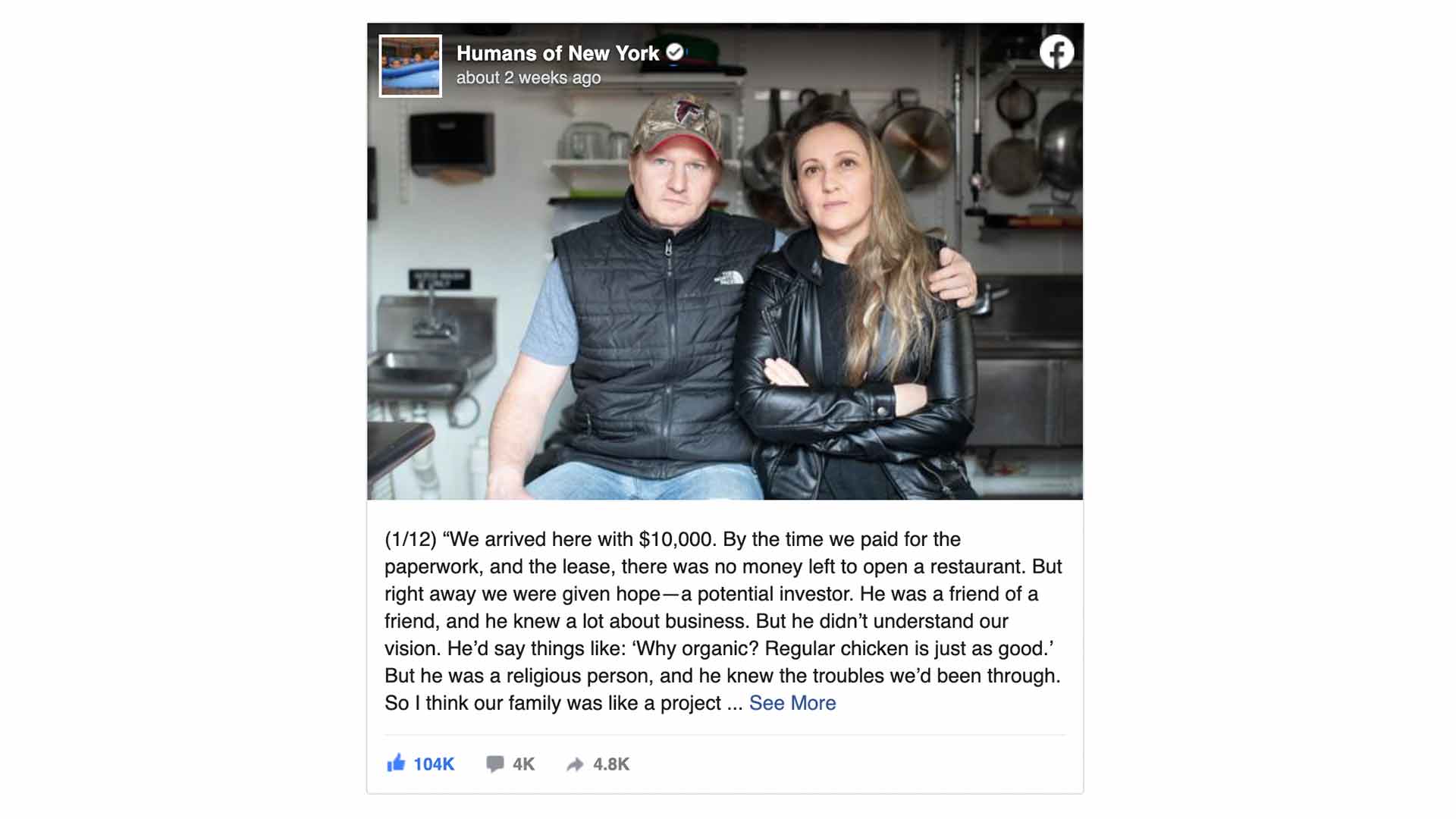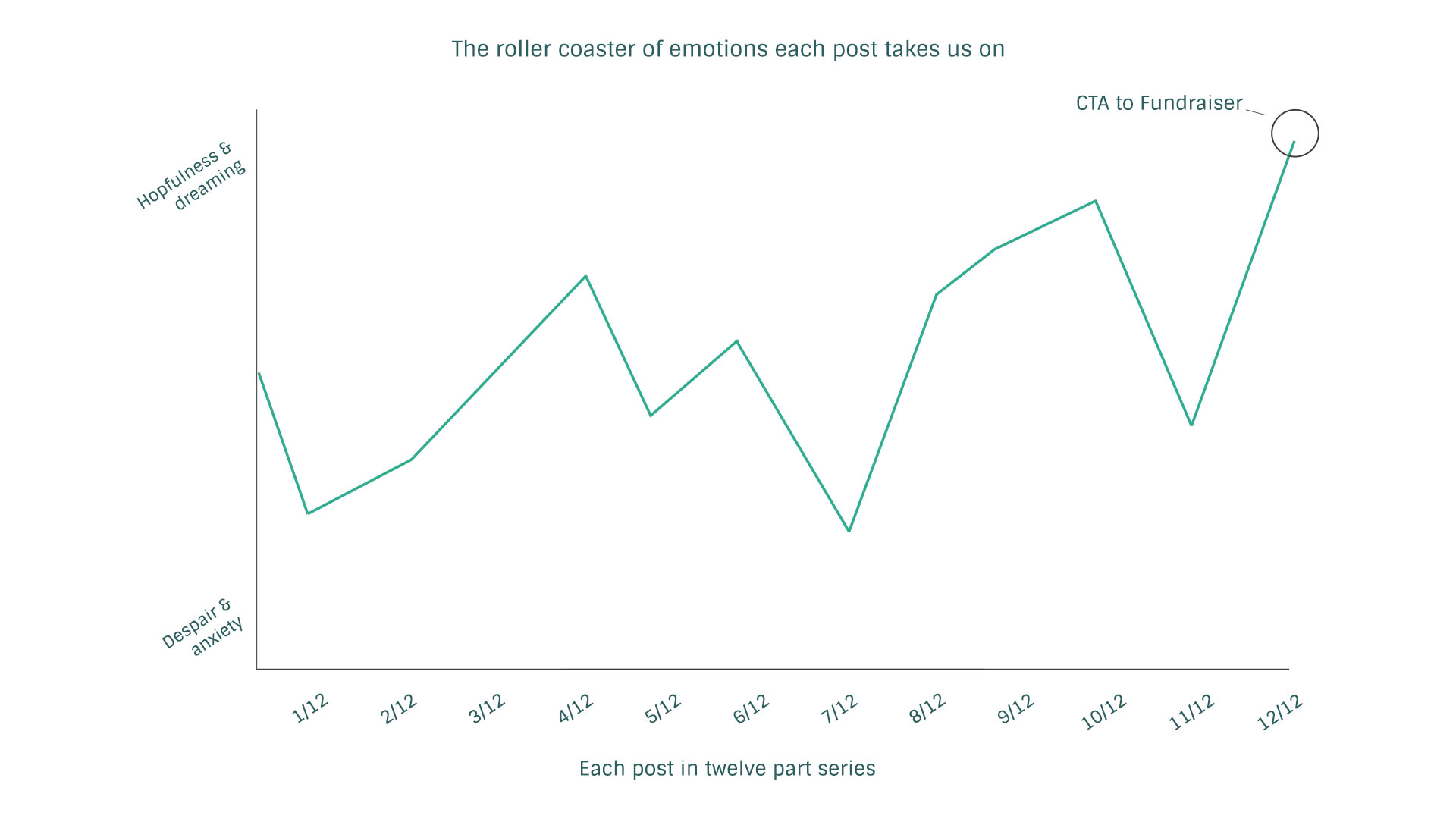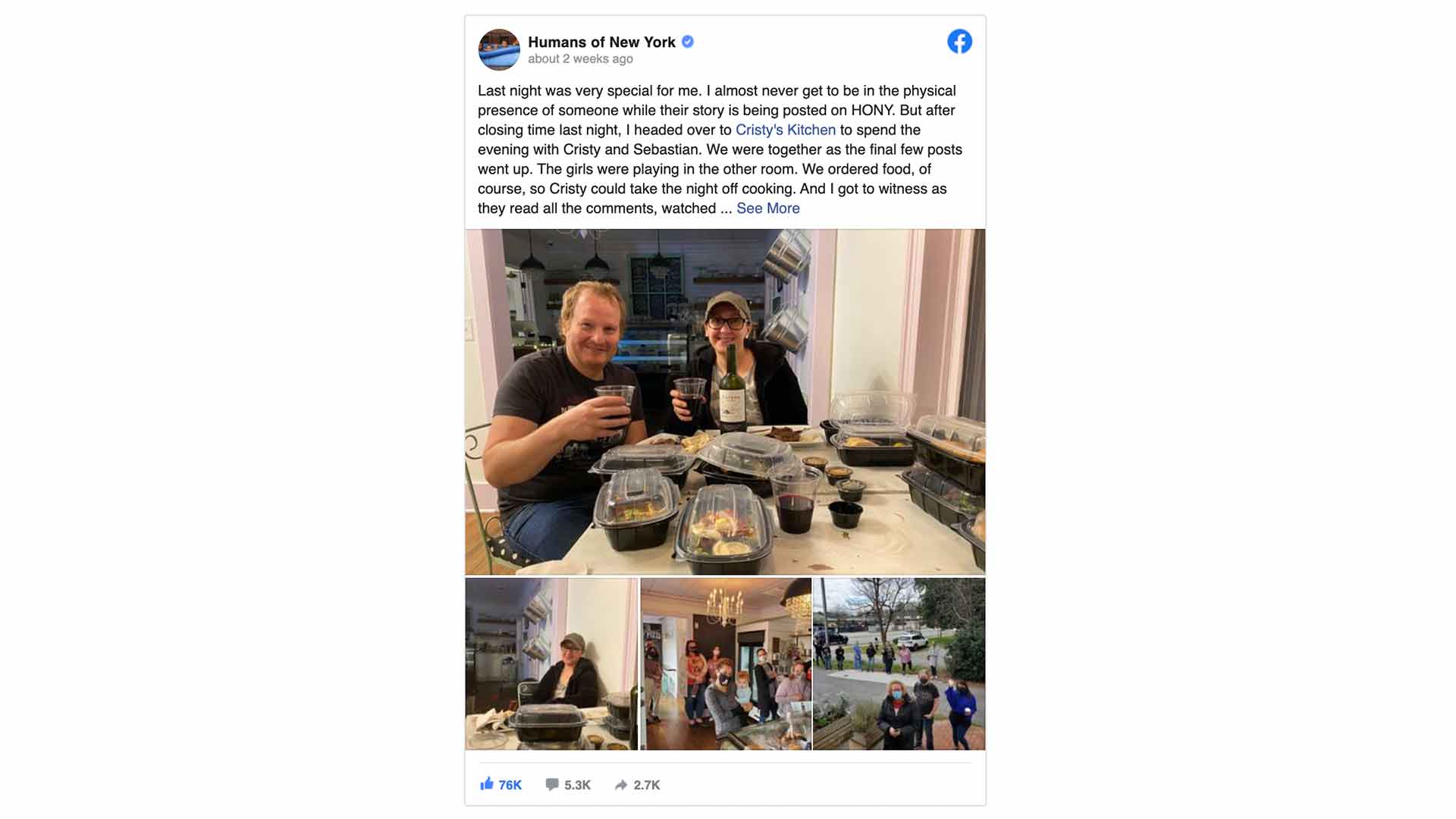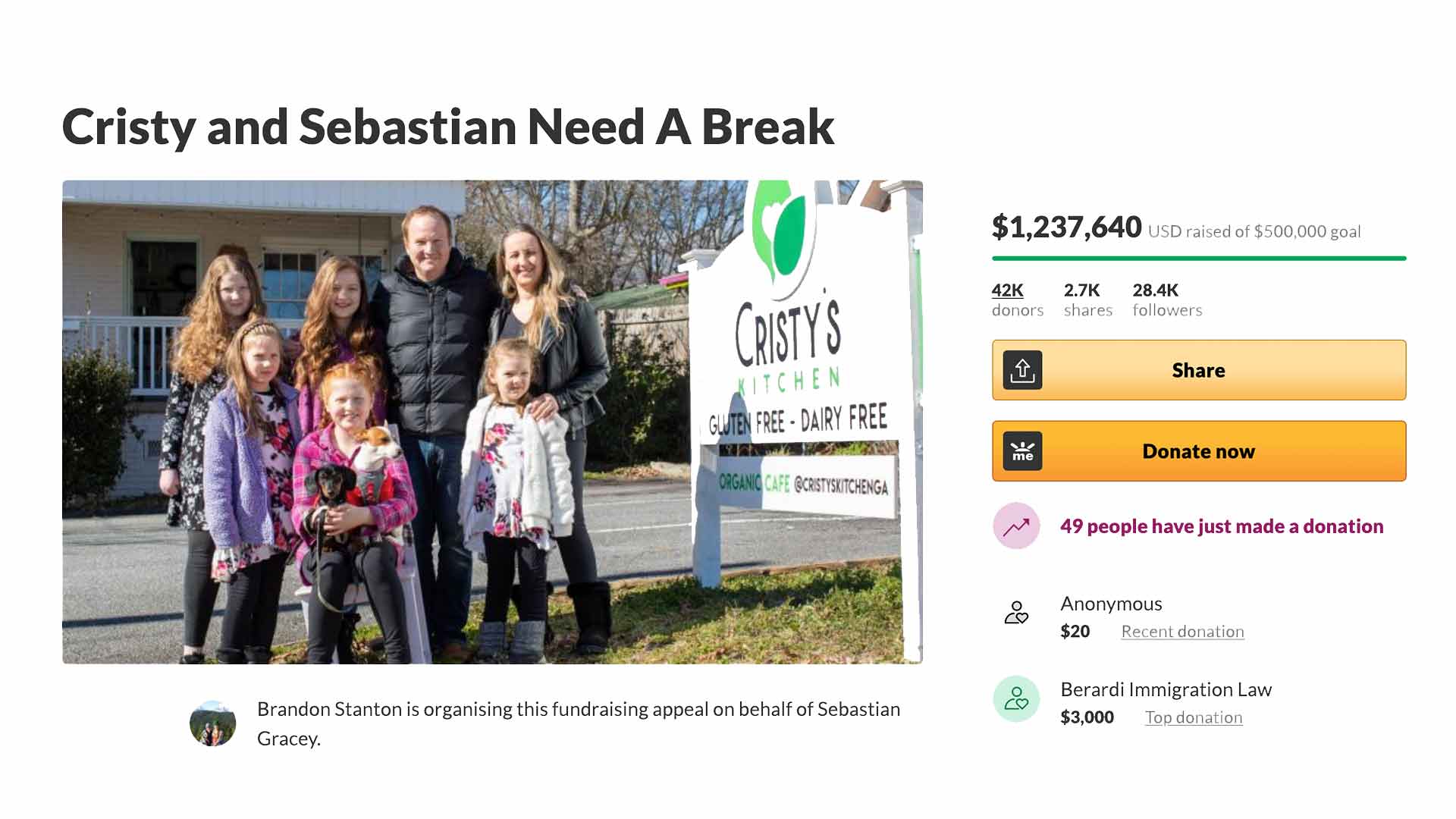How 12 Facebook posts raised over $1M
As a content marketer, I’m always learning about how to write better. So, when Humans of New York captivated me and over 40,000 others to donate over $1,000,000 to help a family-run restaurant in Georgia I couldn’t help but want to know how he did it.

By Ryan Carruthers
April 3, 2021
While scrolling aimlessly through my Facebook feed, I stopped on a post by Humans of New York. I saw a picture of what I assumed was a husband and wife standing together with a kitchen in the backdrop.
They looked serious with their arms crossed and serious expressions. The post indicated that it was the first of twelve, which meant that this tough-looking couple must have a good story.
“After reading the first posts, I had to see the second, the third, the fourth, etc. I was hooked. And clearly, I wasn’t the only one.”

After reading the first posts, I had to see the second, the third, the fourth, etc. I was hooked. And clearly, I wasn’t the only one. After spending the better part of an hour reading all twelve posts and shamelessly tearing up more than once, I saw a fundraising link at the bottom.
I was invested in their story and felt I had to support them. When I clicked the GoFundMe link, I saw that I wasn’t the only one who felt that way.
Humans of New York captivated me and over 40,000 others to cumulatively blow past the goal of $500,000 and donate over $1,000,000 to help a family-run restaurant in Georgia. Wow.
Recently, I was stopped by a Humans of New York post featuring a serious-looking couple with their arms crossed and serious expressions.
— Ryan Carruthers (@ryancarr678) April 6, 2021
The post was the first of 12, which meant that this couple must have a good story. Little did I know that these 12 posts would raise $1m... pic.twitter.com/TxEb3mMjRG
Why does this matter?
As a content marketer, I’m constantly reading and learning about how to write better. Writing compelling introductions and hooks are essential skills for writers because it determines if audiences will stick around to hear what else you have to say.
What journalists call the leade, the introduction needs to pull the reader into the story and keep them engaged.
So, when I realized that the Humans of New York post had so effectively hooked me for almost an hour and compelled me to hand over my money, I couldn’t help but want to know how he did it.

Let’s back up: who is HONY and Cristy’s Kitchen?
Humans of New York
Humans of New York (or HONY) was a passion project of Brandon Stanton back in 2010. He planned to take 10,000 portraits of New Yorkers to plot across a map of the city.
The real and intimate stories behind the people Brandon photographed quickly generated him an audience on Facebook.
The project quickly evolved as people showed interest in the authentic experience of those behind the pictures.
Since 2010, Brandon has published four books on his work, been named one of Time’s “30 Under 30 People Changing The World”, interviewed Barack Obama, documented the stories of refugees with the (UNHCR), and much more.
Cristy's Kitchen
Located in Roswell, GA, Cristy and Sebastian from Peru run Cristy’s Kitchen. They “believe in the power of food to prevent and heal” by using organic and healthy ingredients. They’re also the subject of one of Brandon’s most recent series of posts.
I’d encourage you to go and read the series on HONY’s Facebook page or his website. You, too, will see how captivating and compelling their story is.
Additionally, you’ll have the proper context for the rest of this article. Come back to this after and see if there’s anything you’d add to what I have.
“We get a glimpse into their entrepreneurial struggle of growing a small business.”
Humans of New York’s twelve-part series on Cristy’s Kitchen
HONY published twelve posts detailing the story of Cristy, her family, and their journey to America to open a health foods cafe. Brandon crafts the story to take us through the roller coaster of Cristy and Sebastian’s journey.
He provokes our emotions of hope, fear, and empathy as he tells the incredible story of Cristy and Sebastian.
In a world with shockingly short attention spans, Brandon was able to keep us glued to his page, waiting for the next part of the story to be published.
The factors that led to over $1M in donations to Cristy’s Kitchen
Rags-to-riches and rebirth story archetypes
There are seven basic plots when it comes to telling stories. Of the seven narrative archetypes, the two that, I believe, fit within Cristy and Sebastian’s story are the rags-to-riches and rebirth story archetypes.
- Rags-to-riches stories follow an upstanding but downtrodden character who overcomes their adversities through their talents and force of will. It’s the classic American dream story.
- Rebirth stories outline a character’s seeming defeat until a series of miraculous events bring them back as victorious.
The Rags to Riches archetype makes the most sense because Cristy and her family fit into the classic American dream story.
But the archetype of the rebirth could also fit here. Cristy’s family is reborn, in a way, through the fundraiser that Brandon put together. Running a small business is hard enough, but the pandemic has made it even more severe.
The original rebirth story, Jesus’ resurrection, is a miracle. Similarly, the amount raised for Cristy’s Kitchen can also feel like a miracle.
Both archetypes fit into this story and pull us along, rooting for their family to make it through their trials.
The flow of the posts
The series starts by steeping you into the context of their story. Part one takes place in the middle of the story after they’re already in Georgia with their restaurant.
Parts two and three give background for who Cristy is and how she met her future husband. It colours their character, temperament, and nuances of their relationship as well as defining moments.
Parts four and five reveal the health problems of their daughters and Sebastian’s furniture business. Cristy turns to food to heal their daughters, which gives birth to the idea and dream of starting a cafe.
Six through nine further builds the dream of having their specialty bakery while simultaneously details the unravelling of Sebastian’s business which ultimately leads to his heart attack and bankruptcy.
These events are the turning point where they decided to give up that dream and instead rebuild their lives in America. When they had nothing left in Peru, the opportunity to go to America to start their cafe comes about.

Parts 10 and 11 bring the story into the present, where they are trying to get Cristy’s Kitchen off its feet. We get a glimpse into their entrepreneurial struggle of growing a small business. It emphasizes the humility Sebastian shows to give up his dream of having a furniture business for the sake of his family.
Although they are now in America and building their business, it is still a struggle. Their daughters need a mother, Cristy and Sebastian need rest, and amidst their struggle, the pandemic has compounded the difficulty of starting a business.
The final part comes full circle. It recounts Cristy’s experience with a customer she’s been serving since she first came in after being diagnosed with cancer.
Her encouragement to her to believe that she was going to heal was like speaking to a mirror. It shows her growth and how far she and her family has come. She’s now a leader to others going through challenges because she is overcoming her own.
We, as the audience, are now invited into their story to help them by donating to their fundraiser.
“The best way to sell something is by creating a story around it.”
Made to Stick scorecard
In Chip and Dan Heath’s book, Made to Stick they outline the six elements that make ideas stick. They are simplicity, unexpectedness, concreteness, credibility, emotion, and stories.
They use the SUCCESs scorecard to grade messages based on those six elements.
Simple ❌
It was a long story, so there wasn’t a core message it was trying to get across.
Unexpected ✅
Each part of the series would end with a cliffhanger to compel the reader onto the next post.
Concrete ❌
It wasn’t trying to communicate a point or thesis. Instead, it was a story.
Credible ✅
It was a credible story because it was their first-hand experience documented by a reputable organization, HONY.
Emotional ✅
The story pulls you along their hardships and leads you to develop empathy for them.
Story ✅
It’s a remarkable rags-to-riches story.

Why storytelling sells
The best way to sell something is by creating a story around it. Steep a product or service in meaning, conflict, character development, and emotion, and you’ll break through people’s skepticism and apprehension to sales pitches.
There’s a lot of science behind great storytelling. To quote the Sales Bench Marking Index, a management consulting firm specializing in sales and marketing:
“When we listen to a standard presentation or boring lecture, the Broca’s area of the brain is stimulated. This area deals with language and logic. In contrast, when we are told a story with rich meaning and visual cues, things change dramatically. Both the right and left sides are activated. The right side (creative side) is engaged and stimulated. Stories grip us and help us experience emotions.”
Telling a story activates our emotional side of the brain as well as the logical side. Donald Miller, the author of Building a Story Brand, trains business leaders and marketers on how to make great storytelling a competitive advantage. His seven steps to brand messaging include:
- Making your audience the hero.
- Being a guide with a solution (“your audience is Luke Skywalker. You get to be Yoda”).
- Creating a clear plan for a solution.
The thing to remember is if you can support an argument with a story, you’ll be better off than trying to convince someone with strictly rational reasoning.
Takeaways for great storytelling
The story of Cristy and her family resonated with me enough that I felt compelled to write a post about it. I wanted to learn how to write and tell stories like HONY.
A compelling narrative is the most effective way to market anything, and being a content marketer is all about storytelling and convincing writing.
From diving into the story of Cristy’s Kitchen, I learned that for great storytelling:
- You can’t ignore character development. HONY dedicated two whole parts of the twelve to giving background on Cristy and her family. Further posts are steeped in the characters and how their responses to conflicts reveal their character.
- Use cliffhangers and hooks to keep people coming back. Leveraging unexpectedness as Made to Stick outlines is a great way to maintain interest. At the end of each post, there’s an unmet expectation. For example, in the second post, it ends with “you never know,” she said. ‘You might meet somebody.” We’re left wanting to know who she meets.
- Play into the emotions we all share. HONY dives into Cristy and her family’s feelings while they were going through all their challenges. We empathize with them because of it. We know what it’s like to feel scared or hopeful about our futures.
Follow these three things when writing or telling stories in the future, and you, like Humans of New York, could write a million-dollar story.
